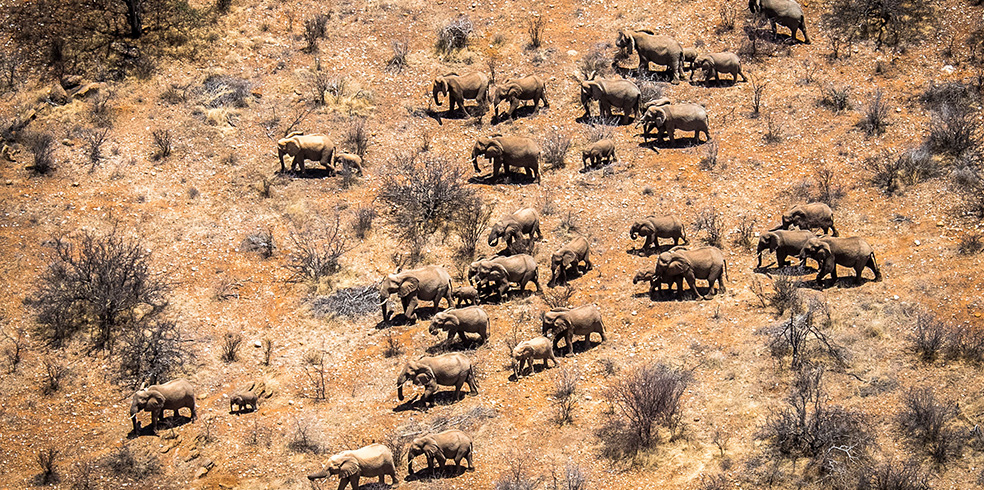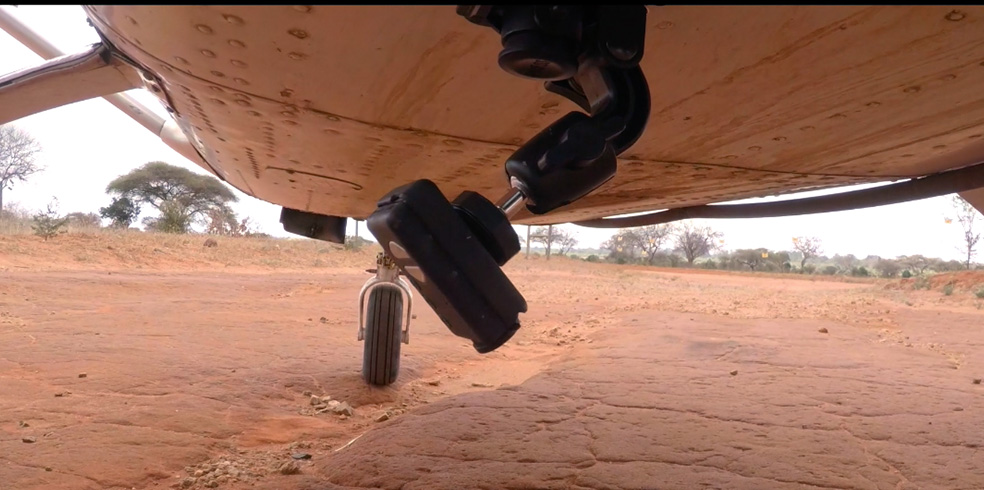Counting wildlife is critical for management but is expensive and surprisingly hard. Luckily a new improved technique is on the horizon. Save the Elephants has trialled a new way of counting wildlife over large areas with an innovative method called the Oblique Camera Count, in partnership with survey expert Dr Richard Lamprey (who developed the technique), the Kenya Wildlife Service and the Department of Resource Surveys and Remote Sensing.
The new technology – using an automated high-definition oblique camera system, improves multi-species aerial counts with better accuracy and efficiency. It could also signal the end of traditional, expensive methods using human observers. A paper on the results has been released. Find out more about this exciting new breakthrough and scroll to the bottom of the page to watch a film about the new trial.
ABOUT THE OBLIQUE CAMERA COUNT
What is an Oblique Camera Count?
The Oblique Camera Count (OCC) embraces new technologies to improve multi-species aerial counts. Aerial counts are a critical tool for providing fundamental data for wildlife management.
Existing standard methods for counting wildlife over large areas use light aircraft flying low over terrain in transects while rear seat observers count animals. The two main variants are Sample Counts (where numbers of wildlife seen within a sample strip are counted, and the total estimated with statistical techniques) and Total Counts (where all observed animals are counted). Kenya traditionally conducts total counts. The recent Great Elephant Census, a pan-African count, used sample counts.
Working with Kenya Wildlife Service and the Department of Resource Surveys and Remote Sensing, Save the Elephants commissioned a trial of the innovative OCC method in Tsavo, Kenya, to compare an automated high-definition oblique camera system to traditional techniques. Approximately 180,000 images were captured during the exercise, which were analysed by photo interpreters in order to produce the most accurate count yet conducted.
What are the advantages of this type of technology?
Accuracy, and efficiency.
In traditional aerial wildlife surveys, human observers are fallible. Fixed-wing aircraft have to fly above a certain speed to remain aloft, and in areas where many individuals occur, or where several species occur together, human observers are unable to make an accurate count in the time that the animals are in view. On hot days, animals seek shade and can be hard to spot with eyes that adjusted for bright sunlight. And sitting for long hours in small, hot, turbulent cockpits can leave human observers prone to fatigue and sometimes airsickness.
Modern high-resolution camera systems effectively provide a freeze-frame of the landscape at the time that the survey aircraft passed, allowing the survey zone to be analysed slowly and more accurately. The survey can also be repeated if necessary, simply by re-analysing the photos. This allows a much more accurate estimate of how many animals are present in the landscape.
In this trial, all photographs were analysed by human teams of interpreters, but this was a time-consuming and expensive process: it took a team of 12 people 9 months to complete. Artificial Intelligence promises significant savings in both time and cost in the processing phase. In future it is possible that the camera systems could be mounted on drones, allowing further savings.
Why choose Tsavo for the count?
The Tsavo Conservation Area – Kenya’s biggest wildlife area – was selected because it provided an opportunity to test the OCC method against traditional aerial survey methods. Immediately after the KWS total count of Tsavo in 2017, an aircraft was dispatched carrying both humans and cameras, allowing comparison of the total count technique with both the sample count and the OCC method. A comparison between total count and sample count estimates had already been conducted in 2014, when the first (sample) count of the Great Elephant Census was flown immediately after the total count.
What do the results show?
Human eyes in hot cockpits miss a lot of things, according to the results.
When compared to the analysed OCC photo dataset, rear seat observers in the same aircraft as the cameras missed 14% of elephants, 60% of giraffe, 48% of zebra and 66% of large antelopes. The observers in the total count conducted two weeks before missed 27% of elephants, 33% of buffalo, 57% of giraffe and 85% of elephant carcasses.
The results imply that rear seat observer-based methods conducted in East Africa over the past 60 years significantly underestimated some wildlife populations. This was presumably due to the fact that human observers often fail to detect animals due to the fact they were simply overlooked or unavailable for detection due to dense vegetation cover.
Does this mean there’s more wildlife in Kenya than there were previously?
No, the results of the OCC do not mean there has been an increase in wildlife numbers in Kenya. Counting methods (including the OCC) always provide estimates, as due to the size of the areas being considered it is impossible to be sure every animal has been included. The OCC method simply means we are now able to count wildlife numbers more accurately. In future they will become more economical as well, as Artificial Intelligence promises to cut costs of interpretation, and drones promise to cut costs of flight time.
Does this mean wildlife is not in fact in crisis?
The UN’s Wildlife Trade regulation body, CITES, determines the level of protection for endangered species on the basis of trends rather than a total count of species. Trends are the most important indicator as they determine the level of threat of a species, and absolute numbers are no protection against overexploitation.
For example, STE’s founder, Iain Douglas-Hamilton launched the first systematic census of Africa’s elephants in 1976 and estimated there to be 1.3 million elephants. By 1989 more than half had been lost – only 600,000 remained. More recently Tanzania – until then home to Africa’s second largest population of elephants – lost 60% of their number in just five years.
Does this mean the data from previous surveys is no longer useable?
As survey techniques evolve, it’s imperative to preserve the historical trends in wildlife numbers. This means creating correction factors to allow new data to be put into context with what has happened in previous years. Running different survey techniques at the same time allows such correction factors to be established.
Why do we need wildlife surveys?
Wildlife surveys provide the most fundamental of metrics about how wildlife is faring: their population. By measuring this over time it is possible to chart the influence of various factors on the different species. These factors can be natural (like drought) or directly related to human impact (like poaching). For wildlife biologists and protected area managers like the Kenya Wildlife Service, measuring the population of a wildlife species is akin to taking its pulse. It is an indication if all is well, or if there is a problem.
Video by Robbie Labanowski. Images by Robbie Labanowski and Jane Wynyard/STE



